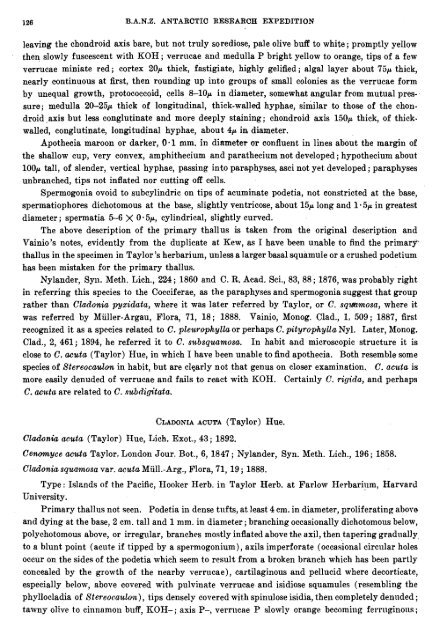You also want an ePaper? Increase the reach of your titles
YUMPU automatically turns print PDFs into web optimized ePapers that Google loves.
126 B.A.N.Z. ANTARCTIC RESEARCH EXPEDITION<br />
leaving the chondroid axis bare, but not truly sorediose, pale olive buff to white ; promptly yellow<br />
then slowly fuscescent with KOH ; verrucae and medulla P bright yellow to orange, tips of a few<br />
verrucae miniate red; cortex 20p thick, fastigiate, highly gelified; algal layer about 75,~ thick,<br />
nearly continuous at first, then rounding up into groups of small colonies as the verrucae form<br />
by unequal growth, protococcoid, cells 8-lop in diameter, somewhat angular from mutual pressure;<br />
medulla 20-25p thick of longitudinal, thick-walled hyphae, similar to those of the chondroid<br />
,axis but less conglutinate and more deeply staining; chondroid axis 150p thick, of thickwalled,<br />
conglutinate, longitudinal hyphae, about 4p in diameter.<br />
Apothecia maroon or darker, 0.1 mm. in diameter or confluent in lines about the margin of<br />
the shallow cup, very convex, amphithecium and parathecium not developed ; hypothecium about<br />
100p tall, of slender, vertical hyphae, passing into paraphyses, asci not yet developed ; paraphyses<br />
unbranched, tips not inflated nor cutting off cells.<br />
Spermogonia ovoid to subcylindric on tips of acuminate podetia, not constricted at the base,<br />
spermatiophores dichotomous at the base, slightly ventricose, about 15p long and 1-5p in greatest<br />
diameter; spermatia 5-6 X 0.5p, cylindrical, slightly curved.<br />
The above description of the primary thallus is taken from the original description and<br />
Vainio's notes, evidently from the duplicate at Kew, as I have been unable to find the primary<br />
thallus in the specimen in Taylor's herbarium, unless a larger basal squamule or a crushed podetium<br />
has been mistaken for the primary thallus.<br />
Nylander, Syn. Meth. Lich., 224 ; 1860 and C. R. Acad. Sci., 83, 88 ; 1876, was probably right<br />
in referring this species to the Cocciferae, as the paraphyses and spermogonia suggest that group<br />
rather than Cladonia pyzidata, where it was later referred by Taylor, or C. sqzaamosa, where it<br />
was referred by Miiller-Argau, Flora, 71, 18; 1888. Vainio, Monog. Clad., 1, 509 ; 1887, first<br />
recognized it as a species related to C. plezbrophylla or perhaps C. pityrophylla Nyl. Later, Monog.<br />
Clad., 2, 461; 1894, he referred it to C. szrbsqwlmosa. In habit and microscopic structure it is<br />
close to C. acuta (Taylor) Hue, in which I have been unable to find apothecia. Both resemble some<br />
species of Stereocadon in habit, but are clearly not that genus on closer examination. C. acuta is<br />
more easily denuded of verrucae and fails to react with KOH. Certainly C. rigida., and perhaps<br />
C. aczbtu are related to C. .rzbbdigitata.<br />
CLADONIA ACUTA (Taylor) Hue.<br />
Cladon& acuta (Taylor) Hue, Lich. Exot., 43 ; 1892.<br />
Canomyce aczlta Taylor, London Jour. Bot., 6, 1847; Nylander, Syn. Meth. Lich., 196; 1858.<br />
Cladonia squamosa var. acuta Miil1.-Arg., Flora, 71, 19 ; 1888.<br />
Type : Idznds of the Pacific, IIooker Herb. in Taylor Herb. at Farlow Herbaripm, Harvard<br />
University.<br />
Primary thallus not seen. Podetia in dense tufts, at least 4 cm. in diameter, proliferating abore<br />
and dying at the base, 2 cm. tall and 1 mm. in diameter; branching occasionally dichotomous below,<br />
polychotomous above, or irregular, branches mostly inflated above the axil, then tapering gradually<br />
to a blunt point (acute if tipped by a spei-mogonium), axils imperforate (occasional circular holes<br />
occur on the sides of the podetia which seem to result from a broken branch which has been partly<br />
concealed by the growth of the nearby verrucae), cartilaginous and pellucid where decorticate,<br />
especially below, above covered with pnlvinate verrucae and isidiose squamules (resembling the<br />
phyllocladia of Stereocazbhz) , tips densely covered with spinulose isidia, then completely denuded ;<br />
tawny olive to cinnamoil buff, ICOH-; axis P-, verrncae P slowly orange becoming felsrnginons;

















